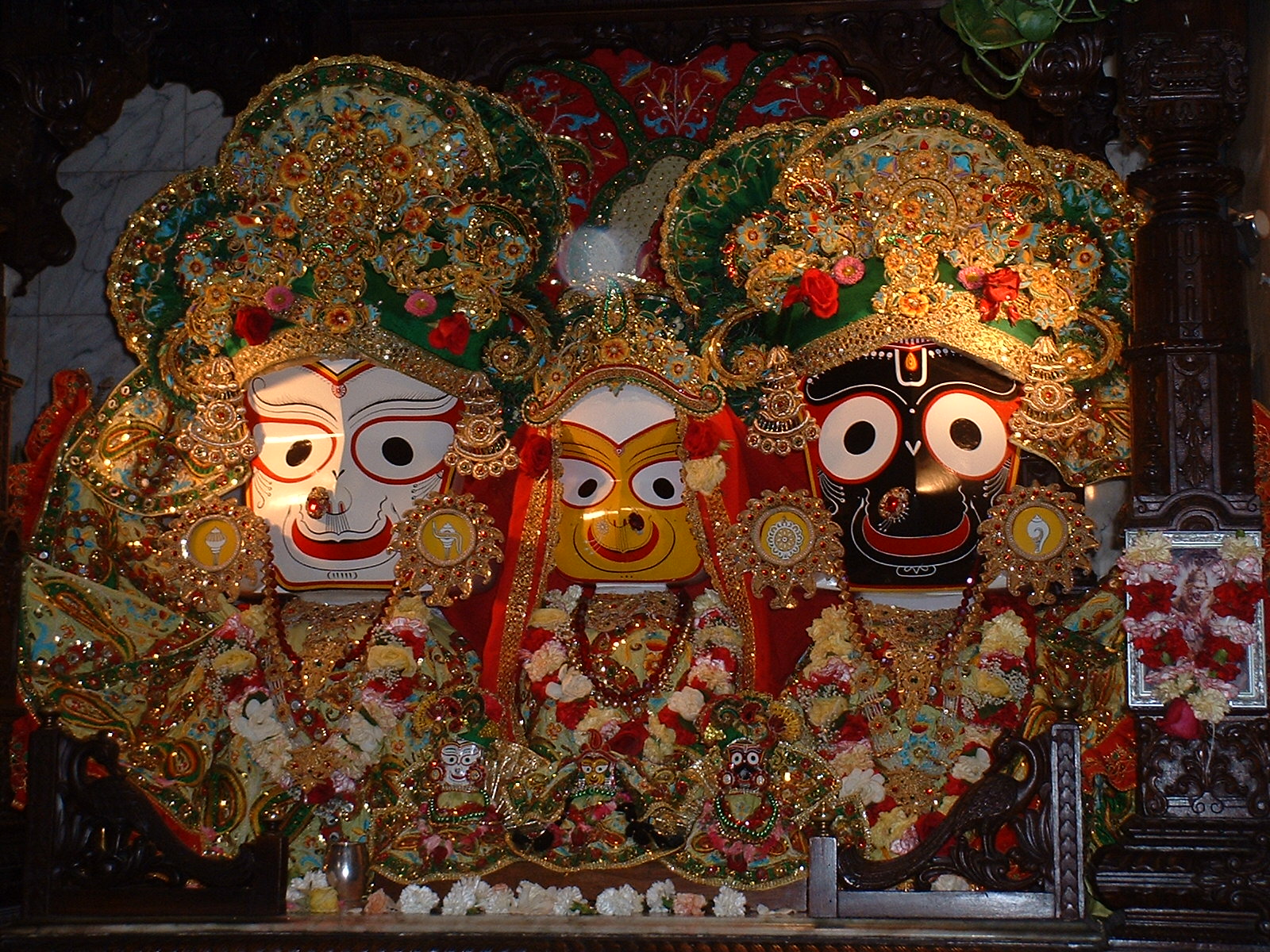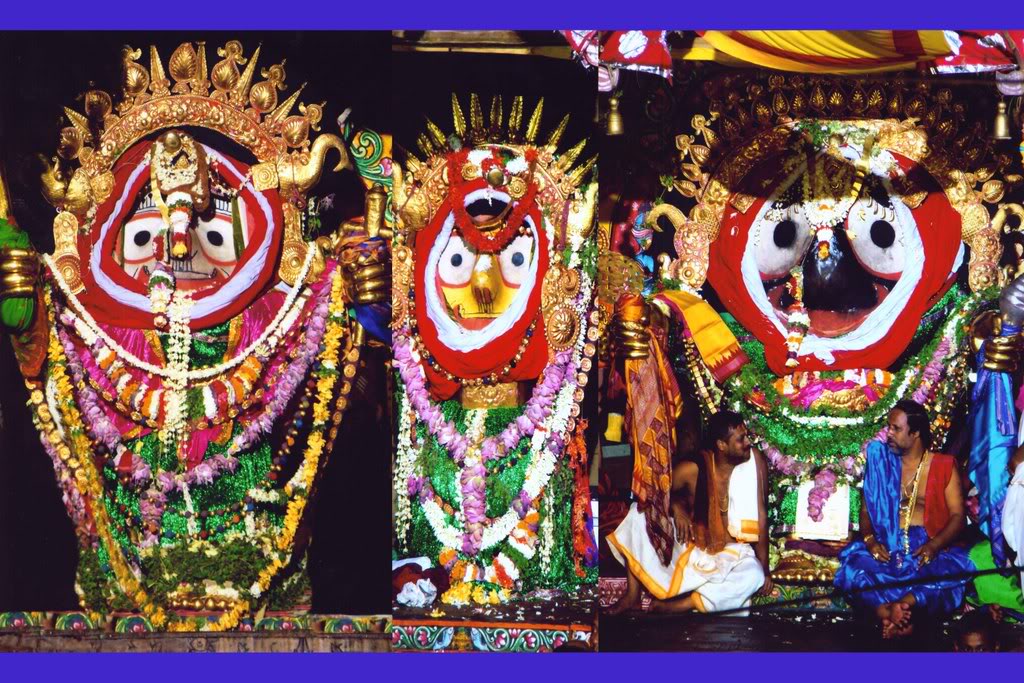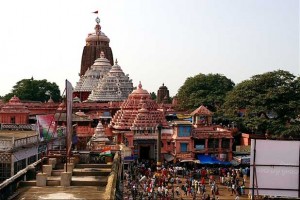Lord Jagannath Rath Yatra
Lord Jagannath Rath Yatra
The Rath Yatra is the biggest festival celebrated each year in Puri – one of India’s holiest cities located on the eastern coast in the state of Orissa. The word rath means ‘chariot’ while yatra means ‘pilgrimage’ or ‘journey’. Every year, Lord Jagannath makes the journey along with his brother Lord Balabhadra and his sister Devi Subhadra, from their home at the Jagannath temple to the Gundicha temple three kilometres away where they visit their aunt for nine days.
Elaborate preparations start months before the festival day. 150 carpenters work for a two-month period on building the three huge chariots – one for each of the three deities. 20 sculptors then create the intricate wood carvings which decorate the chariots.
The chariots are painted in bright colours and decorated with appliqué work. A whopping 8 million rupees (145,000EUR / 210,000CAD / 198,000USD) are spent on the preparations for the event.
Every year approximately 700,000 devotees from all over India and different parts of the world come to Puri on July 16th to witness the Rath Yatra. This is the only time of the year that non-Hindus have the chance to catch a glimpse of Lord Jagannath [as they’re not allowed into his temple] As Jagannath is a manifestation of Lord Krishna, this is a particularly important event for Hare Krishna devotees.

Grand Road, the wide thoroughfare in front of the Jagannath temple where the three chariots stand, ready for the journey
The three chariots of Balabhadra, Subhadra and Jagannatha are newly constructed every year with wood of specified trees like phassi, dhausa, etc. customarily brought from the ex-princely state of Dasapalla, by a specialist team of carpenters who have hereditary rights and privilege for the same. The logs are traditionally set afloat as rafts in the river Mahanadi. These are collected near Puri and then transported by road.
The three chariots, newly constructed every year and decorated as per the unique scheme prescribed and followed for centuries stand on the Bada Danda, the Grand Avenue. Covered with a bright canopies made of stripes of red cloth combined with those of black, yellow and blue colours, the huge chariots are lined across the wide avenue right in front of the majestic temple close to its eastern entrance, also known as the Sinhadwara or the Lion’s Gate.
Lord Jagannatha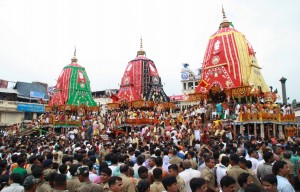 ’s Chariot is called Nandighosa. It is forty-five feet high and forty-five feet square at the wheel level. It has sixteen wheels, each of seven feet diameters, and is decked with a cover made of red and yellow cloth. Lord Jagannatha is identified with Krishna who is also known as Pitambara, the one attired in golden yellow robes and hence the distinguishing yellow stripes on the canopy of this chariot.
’s Chariot is called Nandighosa. It is forty-five feet high and forty-five feet square at the wheel level. It has sixteen wheels, each of seven feet diameters, and is decked with a cover made of red and yellow cloth. Lord Jagannatha is identified with Krishna who is also known as Pitambara, the one attired in golden yellow robes and hence the distinguishing yellow stripes on the canopy of this chariot.
The Chariot of Lord Balabhadra, called the Taladhwaja, the one with the Palm Tree on its flag, has fourteen wheels, each of seven feet diameters and is covered with red and blue cloth. Its height is forty-four feet.
The Chariot of Subhadra, known as Darpadalana, literally trampler of pride, is forty-three feet high with twelve wheels, each of seven feet diameters. This Chariot is decked with a covering of red and black cloth, black being traditionally associated with Shakti and the Mother goddess.
Around each of the chariots are nine Parsva devatas, painted wooden images representing different deities on the chariots’ sides. Each of the chariots is attached with four horses. These are of different colours – white ones for Balabhadra, dark ones for Jagannatha and red ones for Subhadra. Each chariot has a charioteer called Sarathi. The three charioteers attached to the chariots of Jagannatha, Balabhadra and Subhadra respectively are Matali, Daruka and Arjuna.
Pahandi
The journey of the  deities to the world outside, starts with an elaborate royal ritual called Pahandi – literally, going forward in a step by step movement to the accompaniment of several devotees beating the ghanta, kahali and telingi baja.
deities to the world outside, starts with an elaborate royal ritual called Pahandi – literally, going forward in a step by step movement to the accompaniment of several devotees beating the ghanta, kahali and telingi baja.
The ghanta is a type of a gong, shaped like a flattish hollow bowl, and is made of kamsa, bell metal, an alloy of brass and zinc. A small baton like stick made of a hard but flexible piece of cane is used to beat the simple musical instrument. The ghanta is made by traditional artisan groups – kansaris, who live in villages not far from Puri. Kahali is a type of trumpet while the telingi baja is a simple drum, a percussion instrument played on both sides with canes.
The famous saint poet Salabega has immortalised the feelings of the devotees as they wait every year for fulfillment of their desire to see their dear dark darling, Kalia Dhana seated on his resplendent Chariot – Nandi Ghosa. Salabega had gone on pilgrimage and had fallen sick. He couldn’t return in time to see his darling Lord on the chariots and cried out in anguish from 750 miles away. He prayed to the Lord to tarry a while on the bada danda, the Grand Avenue till he could reach back to see the Lord. The compassionate Lord stayed on his chariot which could not be moved an inch forward till Salabega reached Puri and joined the devotees in prayer.
As Lord Jagannatha and Lord Balabhadra are quite heavy, a wooden cross is fixed to their backs and thick silken ropes are tied round their heads and waists for their ceremonial procession – a ritual known as Senapata lagi. The deities during the anasara period are actually placed in the audience hall – Jagamohana and not in the sanctum – or deul on the elevated platform, their normal seat. From there the deities are moved first on to the sata pahacha or seven steps, outside the northern door of the natamandapa or the dancing hall. During the outward movement from the temple to the chariots, the procession of the deities is in a row and is known as dhadi pahandi or a group movement. All the deities move simultaneously. At first Sudarshana, the celestial wheel of Krishna-Vishnu, is brought out and placed in the chariot of Subhadra followed by Balabhadra, Subhadra and finally Jagannatha.
The blowing of kahali, the clang of the ghanta, and the beating of the telingi baja in a unique rhythmic movement slowly rising to a crescendo herald the beginning of their movement.
The two brothers, Balabhadra and Jagannatha are decorated with large, elaborate floral decorations called tahia. These are like huge crowns or tiara but are fixed at the back of their heads. These are made of a variety of white, orange and lotus flowers, leaves and pieces of cork fixed to a semi – circular heart shaped bamboo frame. The two brothers decorated with the tahias are carried forward in a slow, swaying movement, giving the illusion of a huge elephant gracefully and gently stepping out. The privilege of providing these tahias is with the Raghavadasa matha- a monastery associated with the temple. Hundreds and thousands of devotees eagerly await a glimpse of the deities. As the deities step out of the main entrance of the temple, the Sinhadwara – Lion’s Gate, the teeming devotees, bhaktas go wild with ecstasy, chanting the name of the Lord in a loud chorus. The chant Haribol – literally means to utter the name of Hari, the Lord.
First comes Sudarshana who takes its place on the chariot of Subhadra. He is followed by Lord Balabhadra. Much smaller, Subhadra, the yellow-golden coloured younger sister of Jagannatha and Balabhadra, follows soon after. Short and slim, in contrast to her two brothers and much lighter, the lady is carried on the shoulders in a supine state. Her movement is much faster and the daitas carrying her almost rush through the process in a running movement. At last comes Lord Jagannatha, darling of the devotees, in a regal procession. Dancers perform traditional Odissi dance to the accompaniment of mardala and mridanga, traditional Orissan percussion instruments, as the procession moves forward. Devotees also perform sankirtan, ritual group chanting of the names of Lords with rhythmic jumping movements.
Chhera Pahanra
 The second phase of the festival is an equally colourful and elaborate ritual is known as Chhera Pahanra. The Raja, King of Puri, Gajapati Divya Singha Deva is informed of the deities having taken their places on the chariots through a messenger specially deputed by the temple officials. The young, handsome King, clad in spotless white, carried in a silver plated palanquin leaves his palace and comes in a small procession on the grand avenue led by a caparisoned elephant. He climbs the chariots one by one. He first offers his prayers to the deity seated on the chariot. He then cleans the platforms with a golden broom, sprinkling flowers and fragrant water on the surface of the chariot.
The second phase of the festival is an equally colourful and elaborate ritual is known as Chhera Pahanra. The Raja, King of Puri, Gajapati Divya Singha Deva is informed of the deities having taken their places on the chariots through a messenger specially deputed by the temple officials. The young, handsome King, clad in spotless white, carried in a silver plated palanquin leaves his palace and comes in a small procession on the grand avenue led by a caparisoned elephant. He climbs the chariots one by one. He first offers his prayers to the deity seated on the chariot. He then cleans the platforms with a golden broom, sprinkling flowers and fragrant water on the surface of the chariot.
The ritual goes back several hundred years and is a symbol of the subjugation of the temporal to the spiritual. The emperors of Orissa, beginning with the valiant Anantvarman Chodagangadeva in the 12th century, had declared themselves to be the rauta, servant of Lord Jagannatha and ruled the land as His representative. The ritual is also a public demonstration of the unique philosophy of integration and unity symbolised by Lord Jagannatha. There is no distinction of caste, creed or any other barrier during the entire festivities. After cleansing of the chariots by the Raja and his departure to the palace, the wooden horses, brown, black and white, are fixed to the three chariots. Thick ropes made of coconut fibre and 250 feet long are tied to the individual chariots.
Chariots Pulling
The final ritu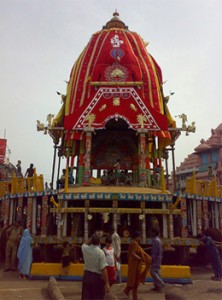 al in the celebration is the pulling of the chariots. The chariot of Lord Balabhadra is pulled first followed by that of goddess Subhadra. At last the grand moment and the climax of the day’s celebration is reached when the chariot of Lord Jagannatha, Nandighosha starts its spectacular journey to the Gundicha temple. Thousands of devotees who patiently wait the whole day for this blessed moment are ecstatic with joy and pull the chariots with a sense of fulfillment.
al in the celebration is the pulling of the chariots. The chariot of Lord Balabhadra is pulled first followed by that of goddess Subhadra. At last the grand moment and the climax of the day’s celebration is reached when the chariot of Lord Jagannatha, Nandighosha starts its spectacular journey to the Gundicha temple. Thousands of devotees who patiently wait the whole day for this blessed moment are ecstatic with joy and pull the chariots with a sense of fulfillment.
In ancient times, the Ratha Yatra of Puri employed six chariots as compared to the three at present times. A river once flowed between the Gundicha House and the Jagannatha temple. Three chariots stayed in readiness on the other side of the river to receive the deities from the three chariots that transported them from the main temple.
Bahuda Jatra
There, in their Garden House, adapa mandapa, also k nown as their place of birth, the deities stay for seven days. On the ninth day of the festival, Bahuda Jatra, the grand return journey takes place. On the way back they stop for a short while and partake of poda pitha, a type of cake made of rice, lentils, jaggery and coconut, offered by their aunt, mausima. On reaching back the main temple, the deities, on their chariots, don the golden attire or the suna besa, with hands, arms and crown made of solid gold. They are also offered sweet drinks, adhara pana, on huge cylindrical earthen pots reaching up to their lips. They are taken down from the chariots in a ritual descent to enter the temple.
nown as their place of birth, the deities stay for seven days. On the ninth day of the festival, Bahuda Jatra, the grand return journey takes place. On the way back they stop for a short while and partake of poda pitha, a type of cake made of rice, lentils, jaggery and coconut, offered by their aunt, mausima. On reaching back the main temple, the deities, on their chariots, don the golden attire or the suna besa, with hands, arms and crown made of solid gold. They are also offered sweet drinks, adhara pana, on huge cylindrical earthen pots reaching up to their lips. They are taken down from the chariots in a ritual descent to enter the temple.
The temple gate is however shut upon Lord Jagannatha by his celestial consort Laxmi. Her anger, jealousy and frustration is articulated by her companions, represented by a group of servitors from inside. Another group representing Lord Jagannatha respond with entreaties and endearments. After re-enacting this drama of daily domestic tiffs of mere mortals, the celestial couple finally make up, and the temple door is opened and the deities return to their bejeweled throne, the ratna sinhasana.

